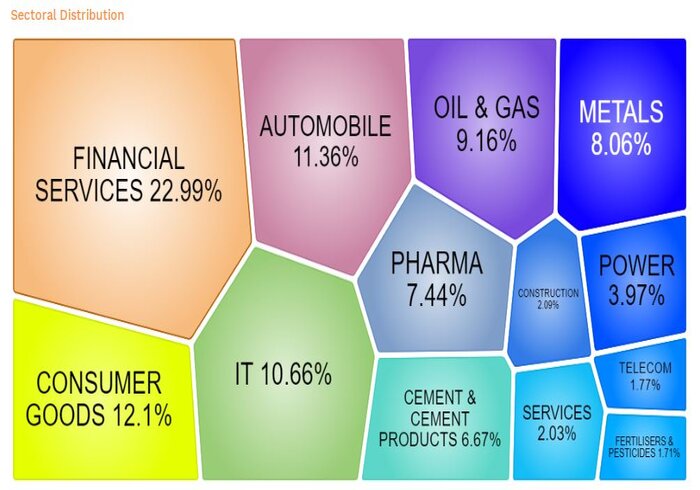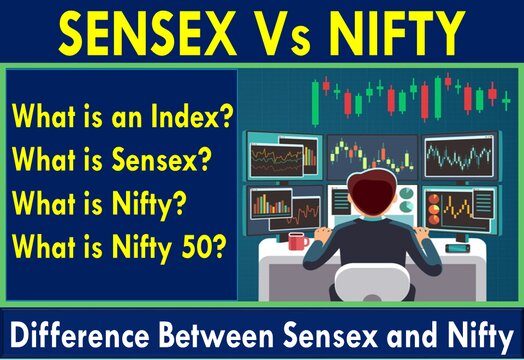What is Sensex and Nifty? NIFTY VS SENSEX: Difference Between SENSEX and NIFTY
If you want to invest in the stock market and generate a good amount of returns, you must have a basic knowledge about the stock market and the terms related to it. If you’re quite aware of the market, you must have heard of terms like NSE, BSE, IPO, NIFTY, SENSEX.
NSE and BSE are the two major stock exchanges in India. They provide a platform to different investors and companies for buying and purchasing stocks.
To achieve the best results out of your investments, you must keep a track of different companies. But this is not practically possible to do as there are more than 1600 listed companies on NSE and 5000 on BSE. So you cannot keep track of all of them in one go.
So, to resolve this problem, the concept of ‘Index’ is introduced in the share market.
What is an Index?
Since evaluating the market’s performance by tracking all the companies is not possible, a group of companies is made. This group consists of a certain number of companies that represents all different sectors that the listed companies belong to. Thus, by tracking the performance of these groups, we can get to know about the health of the whole stock market.
In India, we have two most common and major indices, that are SENSEX and NIFTY. These represent the benchmark index of two different stock exchanges.
What is SENSEX?
Companies raise capital by IPO (Initial Public Offering) and after the IPO gets over, these companies get listed on the stock exchanges such as BSE, NSE. This provides a greater opportunity for the public to buy these shares for the attainment of their short or long term goals.
- Sensex is the benchmark index of Bombay Stock Exchange (BSE).
- It means sensitive and index and it was introduced in 1986.
- Sensex consists of 30 companies that are listed on BSE.
?Demat Account Online खोलें Upstox में ?
Sign up now using my custom referral link below and get FREE benefits like,
✔️FREE demat & trading a/c
✔️Zero brokerage* for 30 days
✔️Money Control pro subscription FREE worth ₹1999
✔️FREE Beginner’s course on the Stock Market at Elearnmarkets worth ₹999
✔️FREE StockEdge Premium worth ₹999
? REFERAL LINK
?: Direct Account Open Link
What is NIFTY?
- Nifty means National Stock Exchange Fifty.
- It is the benchmark index of NSE and was introduced in 1996.
- It consists of a total 50 companies that are listed on NSE.

Nifty 50 Companies List
| Adani Ports and Special Economic Zone Ltd. |
| Asian Paints Ltd. |
| Axis Bank Ltd. |
| Bajaj Auto Ltd. |
| Bajaj Finance Ltd. |
| Bajaj Finserv Ltd. |
| Bharat Petroleum Corporation Ltd. |
| Bharti Airtel Ltd. |
| Britannia Industries Ltd. |
| Cipla Ltd. |
| Coal India Ltd. |
| Divi’s Laboratories Ltd. |
| Dr. Reddy’s Laboratories Ltd. |
| Eicher Motors Ltd. |
| GAIL (India) Ltd. |
| Grasim Industries Ltd. |
| HCL Technologies Ltd. |
| HDFC Bank Ltd. |
| HDFC Life Insurance Company Ltd. |
| Hero MotoCorp Ltd. |
| Hindalco Industries Ltd. |
| Hindustan Unilever Ltd. |
| Housing Development Finance Corporation Ltd. |
| ICICI Bank Ltd. |
| ITC Ltd. |
| Indian Oil Corporation Ltd. |
| IndusInd Bank Ltd. |
| Infosys Ltd. |
| JSW Steel Ltd. |
| Kotak Mahindra Bank Ltd. |
| Larsen & Toubro Ltd. |
| Mahindra & Mahindra Ltd. |
| Maruti Suzuki India Ltd. |
| NTPC Ltd. |
| Nestle India Ltd. |
| Oil & Natural Gas Corporation Ltd. |
| Power Grid Corporation of India Ltd. |
| Reliance Industries Ltd. |
| SBI Life Insurance Company Ltd. |
| Shree Cement Ltd. |
| State Bank of India |
| Sun Pharmaceutical Industries Ltd. |
| Tata Consultancy Services Ltd. |
| Tata Motors Ltd. |
| Tata Steel Ltd. |
| Tech Mahindra Ltd. |
| Titan Company Ltd. |
| UPL Ltd. |
| UltraTech Cement Ltd. |
| Wipro Ltd. |
Difference between Sensex and Nifty
When we want to track the health of the stock market, we look at the status of Sensex and Nifty. These are the Barometers of Indian economy. The movement of Sensex and Nifty is in accordance with the movement of the stocks/companies whom they represent. The movement of these stocks varies according to different activities and depends on various factors.
These factors could be any kind of trade war, political instability in a country, elections, or any kind of global crisis like covid19. Due to these factors, Sensex and Nifty may rise up or fall down suddenly. These simply indicate the investors’ sentiment.
Nifty and Sensex are the barometers of the Indian economy. The markets’ good health simply means the investment culture in a country is in good condition. Nifty and Sensex are the barometers of the Indian economy. The markets’ good health simply means the investment culture in a country is in good condition.
While both Sensex and Nifty are calculated in the same method, still there are differences between both of them.
- The term Nifty is derived from ‘National Fifty’ and Sensex is obtained from ‘Sensitive Index’.
- Sensex is the benchmark index of BSE (Bombay Stock Exchange) and is operated by it. While, Nifty is the index of NSE (National Stock Exchange) and is operated by India Index Services Product Ltd., IISL which is a subsidiary of NSE.
- The base value of Nifty is 1000 and the base value of Sensex is 100.
- Nifty consists of 50 selected stocks from the top 50 companies, which are used to determine the index, while Sensex consists of 30 selected stocks from the top 30 companies, which are used to determine the index.
| Parameters | Nifty | Sensex |
| Full-form | National and Fifty | Sensitive and Index |
| Aliases | Nifty 50 and S&P CNX Fifty | S&P BSE Sensex |
| Owned by | It is both owned and managed by Index and Services and Products Limited (IISL), an NSE subsidiary. | It is owned by the Bombay Stock Exchange (BSE). |
| Base number | Its base number is 1000 | Its base number is 100 |
| Base period | Its base period is 3rd November 1995. | Its base period is 1978 – 79. |
| Base capital | Rs.2.06 trillion | N/A |
| Number of constituents | Nifty 50 constitutes of the top 50 companies that are actively traded in NSE. | Sensex comprises the top 30 companies actively traded in BSE. |
| Number of sectors covered | Nifty is a broader market index that covers 24 sectors. | Sensex covers 13 sectors. |
Major Factors That Affect The Indices:
Stock markets are considered to reflect the health of the economy. When the economy is affected by any factor, the stock market is also affected proportionately. Although there could be numerous factors that affects the health of stock market but the major one are discussed below:
- Inflation Rate:
When the inflation rates are high, the amount that the investors would invest also suffers greatly. Thus, the investments decrease. The companies also suffer because they have to pass the higher input costs to the customers.
- Change in interest rate:
When the interest rates are increased, the borrowing cost for companies increases. To compensate for this, the companies cut their expenses in many ways. This affects the company’s earnings and as a result the stock markets fall.
- Global economy:
When the global economy suffers from recession, the stock market is also affected.
- Other Factors:
Various other factors affecting the health of the stock market could be crude oil prices, rupee depreciation, political instability, etc.
In this article, we learned about Sensex and Nifty, the major indices of Indian Stock market. These help us to predict the status of the market by technically analyzing the stocks. There are a number of factors that affect them. But once we learn about the basics of the stock market, it will be easy for us to understand and trade in them.
We hope you found this article useful. If you still have any doubts regarding this topic, you can ask in the comments section below.
Happy Learning!
| Best Share Trading Apps 2020 | Best Discount Brokers in India |
| How to Open Demat Account? | Best Equity Mutual Funds 2020 |
| Intraday Trading Basics | Tax on Stock Market Income |
Nifty & SENSEX FAQs
Both, Sensex and Nifty are stock exchange indices that determines the performance of the stock market. In simple words, they are the clear indicators of the market movement. Since, Nifty is more diversified and has additional stocks listed as compared to BSE Sensex, more trading is done on it.
Nifty got its name from National Fifty. So the full form of Nifty is National Fifty.
Sensex derived its name from sensitive index i.e. Sensitive Index is the full form of Sensex.
The Sensex is comprised of 30 of the largest and most actively-traded stocks on the BSE, providing a gauge of India’s economy.
Nifty is calculated using 50 large stocks that are actively traded on the NSE.
